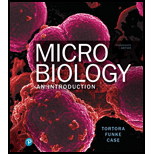
Concept explainers
The thermal death time for a suspension of Bacillus subtilis endospores is 30 minutes in dry heat and less than 10 minutes in an autoclave. Which type of heat is more effective? Why?
To review:
Which type of heat is more effective based on the thermal death time for a suspension of Bacillus subtilis endospores.
Introduction:
Bacillus subtilis is a rod-shaped, Gram-positive bacterium that are naturally found in soil and vegetation. B. subtilis grow in the mesophilic temperature range. The optimal temperature for the growth of this organism is 25ºC -35ºC.
Explanation of Solution
The cell wall is a rigid structure present outside the cell. Bacillus species are generally isolated by soil sprinkle technique and are used in the production of antibiotics. Ethanol, or strong acid or alkali are not effective in destroying the spores of B. subtilis. The use of chemicals generally does not kill the spores, and it only controls their growth and kills the living cells.
The effective way of destroying the endospores is by passing heat. Dry heat will take more time to penetrate through the cell. As moist heat easily penetrates through the cell, it is the effective way for the destruction of the endospores.
Based on the thermal death time (10 minutes) for B. subtilis endospores in an autoclave, moist heat is the effective method to kill B. subtilis endospores. In a sterilizing chamber, autoclave employs high temperature under pressure. It is used in the sterilization for surgical equipment and medical instruments. It is also used in pharmaceutical and food industries. The elevated temperature and pressure with steam creates an environment that is too high for any microorganisms or spores to live.
Moist heat penetrates into the bacterial cells easily and effectively kills vegetative bacteria as well as their spores. Compared to dry heat (thermal death time for B. subtilis endospores: 30 minutes), B. subtilis endospores are more effectively killed by an autoclave (moist heat).
Want to see more full solutions like this?
Chapter 7 Solutions
Microbiology: An Introduction (13th Edition)
Additional Science Textbook Solutions
Biological Science (6th Edition)
Genetics: From Genes to Genomes
Campbell Essential Biology (7th Edition)
HUMAN ANATOMY
Biology: Life on Earth with Physiology (11th Edition)
- What is this?arrow_forwardMolecular Biology A-C components of the question are corresponding to attached image labeled 1. D component of the question is corresponding to attached image labeled 2. For a eukaryotic mRNA, the sequences is as follows where AUGrepresents the start codon, the yellow is the Kozak sequence and (XXX) just represents any codonfor an amino acid (no stop codons here). G-cap and polyA tail are not shown A. How long is the peptide produced?B. What is the function (a sentence) of the UAA highlighted in blue?C. If the sequence highlighted in blue were changed from UAA to UAG, how would that affecttranslation? D. (1) The sequence highlighted in yellow above is moved to a new position indicated below. Howwould that affect translation? (2) How long would be the protein produced from this new mRNA? Thank youarrow_forwardMolecular Biology Question Explain why the cell doesn’t need 61 tRNAs (one for each codon). Please help. Thank youarrow_forward
- Molecular Biology You discover a disease causing mutation (indicated by the arrow) that alters splicing of its mRNA. This mutation (a base substitution in the splicing sequence) eliminates a 3’ splice site resulting in the inclusion of the second intron (I2) in the final mRNA. We are going to pretend that this intron is short having only 15 nucleotides (most introns are much longer so this is just to make things simple) with the following sequence shown below in bold. The ( ) indicate the reading frames in the exons; the included intron 2 sequences are in bold. A. Would you expected this change to be harmful? ExplainB. If you were to do gene therapy to fix this problem, briefly explain what type of gene therapy youwould use to correct this. Please help. Thank youarrow_forwardMolecular Biology Question Please help. Thank you Explain what is meant by the term “defective virus.” Explain how a defective virus is able to replicate.arrow_forwardMolecular Biology Explain why changing the codon GGG to GGA should not be harmful. Please help . Thank youarrow_forward
- Stage Percent Time in Hours Interphase .60 14.4 Prophase .20 4.8 Metaphase .10 2.4 Anaphase .06 1.44 Telophase .03 .72 Cytukinesis .01 .24 Can you summarize the results in the chart and explain which phases are faster and why the slower ones are slow?arrow_forwardCan you circle a cell in the different stages of mitosis? 1.prophase 2.metaphase 3.anaphase 4.telophase 5.cytokinesisarrow_forwardWhich microbe does not live part of its lifecycle outside humans? A. Toxoplasma gondii B. Cytomegalovirus C. Francisella tularensis D. Plasmodium falciparum explain your answer thoroughly.arrow_forward
- Select all of the following that the ablation (knockout) or ectopoic expression (gain of function) of Hox can contribute to. Another set of wings in the fruit fly, duplication of fingernails, ectopic ears in mice, excess feathers in duck/quail chimeras, and homeosis of segment 2 to jaw in Hox2a mutantsarrow_forwardSelect all of the following that changes in the MC1R gene can lead to: Changes in spots/stripes in lizards, changes in coat coloration in mice, ectopic ear formation in Siberian hamsters, and red hair in humansarrow_forwardPleiotropic genes are genes that (blank) Cause a swapping of organs/structures, are the result of duplicated sets of chromosomes, never produce protein products, and have more than one purpose/functionarrow_forward
 Microbiology for Surgical Technologists (MindTap ...BiologyISBN:9781111306663Author:Margaret Rodriguez, Paul PricePublisher:Cengage LearningSurgical Tech For Surgical Tech Pos CareHealth & NutritionISBN:9781337648868Author:AssociationPublisher:Cengage
Microbiology for Surgical Technologists (MindTap ...BiologyISBN:9781111306663Author:Margaret Rodriguez, Paul PricePublisher:Cengage LearningSurgical Tech For Surgical Tech Pos CareHealth & NutritionISBN:9781337648868Author:AssociationPublisher:Cengage





